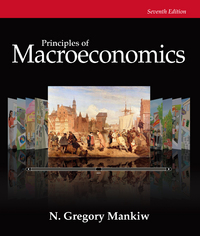Question
Consider the q theory of investment we covered in the first two lectures. Suppose (K) = aK + b, where a < 0 and b
Consider the q theory of investment we covered in the first two lectures. Suppose (K) = aK + b, where a < 0 and b > 0, and the adjustment cost of capital is C(I) = cI2 . Describe the effects of each of the following changes on the = 0 andq = 0 loci, on K and q at the time of the change, and on their behavior over time, with the help of the phase diagram. In each case, assume that K and q are initially at their long-run equilibrium values.
(a) At time 0, the government announces a uniform profit tax which reduces profits to (K) = aK + b , where b < b. This new tax will come into effect at time T.
(b) At time 0, the government announces that a new uniform profit tax bill, as described in (a), will be voted on at time T. It is expected that there will be 50% chance that the tax bill will be passed then.
(c) At time 0, a powerful hurricane hits the country, which destroys 10% of the aggregate capital K.
(d) At time 0, meteorologists predict that a powerful hurricane will hit the country with probability 50% at time T. If it hits, then it will destroy 10% of the aggregate capital K.
Step by Step Solution
There are 3 Steps involved in it
Step: 1

Get Instant Access to Expert-Tailored Solutions
See step-by-step solutions with expert insights and AI powered tools for academic success
Step: 2

Step: 3

Ace Your Homework with AI
Get the answers you need in no time with our AI-driven, step-by-step assistance
Get Started


